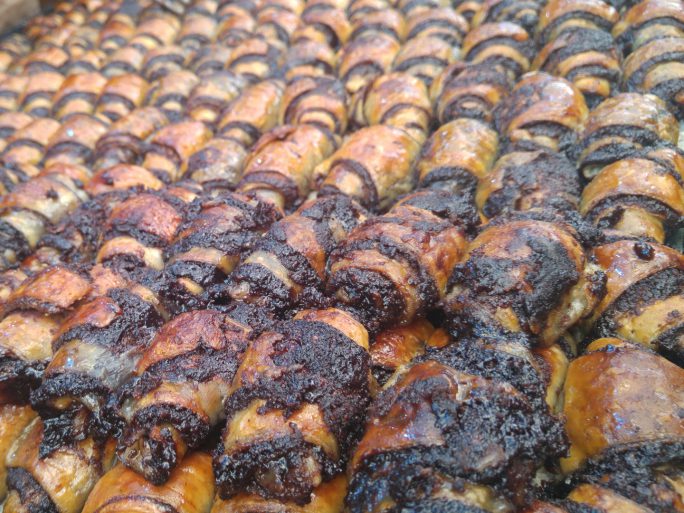Call us today!
+1-917-9055850
Magazine

Israeli Cuisine
In recent years, culinary tours have become an essential experience of every trip abroad.
Strolling through the markets and occasionally getting a bite in one of the local restaurants is one of the best introductions to foreign countries – you can learn a lot about people through their food.
When it comes to Israel, It is situated on a culinary crossroads, and its cuisine is a confluence of cultures, languages, and traditions.
The story begins in 70 AD, after the fall of Jerusalem, when most of the Jewish population that lived in the Land of Israel was exiled and dispersed across Europe, Asia, and Africa.
The connection between the Jewish brothers and sisters was severed, and for 2000 years, each community evolved independently.
During the 20th century, the gates of the Holy Land started to open again, welcoming thousands of Jews back to their homeland.
By this time, each community spoke a different language and developed its own set of customs and traditions.
All of those differences were poured into a melting pot and created the “new Israeli” – a phenomenon that kept on developing with the establishment of the state of Israel in 1948.
From the culinary perspective, each community contributed recipes from their grandmothers’ cookbooks – North Africans brought couscous and shakshuka, Europeans brought gefilte fish, cholent, kugel, and chicken schnitzel, Iraqi Jews brought kubbeh, Yemenite Jews brought malawach and jachnun, Russians brought their famous borscht, Turks brought the bourekas and local Jews that stayed here, have enjoyed hummus and falafel.
With 800,000 that arrived during 1948, Israel’s population grew rapidly in the following years.
This growth was met by food, water, and agriculture challenges that thanks to the people’s ingenuity were soon turned into solutions, and Israel became a leading, self-sufficient country.
Nowadays, with most of its crops grown locally, Israel has a thriving vegan culture, and in addition to the 7 biblical species – wheat, barley, figs, olives, dates, pomegranates, and grapes – you can also find exotic ones, such as bananas, avocados, and mangos.
So, what about actual Israeli food?
Over the years, hummus, falafel, and shawarma became synonymous with Israeli cuisine, however, these dishes are considered Middle Eastern and each of the Arab countries has its own versions.
The following are actual Israeli dishes. Enjoy!
Sabich – This dish with Iraqi roots is a sandwich stuffed with deep-fried eggplant, hard-boiled egg, potatoes, vegetables, and a variety of sauces, such as tahini, amba, and hot sauce.
Very simple and super yummy!
Ptitim – In the first years of Israel’s existence, there was a shortage of rice.
For the Sephardic Jews, it was a major problem since rice is their staple food.
The story goes that Prime Minister David Ben-Gurion asked Osem – one of Israel’s leading food companies – to create a substitute for rice, and the result was “Ptitim”- tiny bits of cooked dough that looked like rice.
The nickname it received was “Ben-Gurion rice.”
Shkedei Marak – Another devise of the Osem food company.
Also known as soup mandels, these are small yellow squares made of flour and palm oil.
Similar to croutons, they are usually added to soups.
Cherry Tomato – First created at the Agriculture Faculty in the city of Rehovot, this small tomato answered the wish for a healthy snack that became particularly popular for TV binge-watching.
Cherry tomato became a global hit and thanks to its long shelf life, it is one of the most successful Israeli exports.
Bamba – These peanut butter puffs are among the most popular local snacks.
Kids just love it! “Bamba” is said to be one of the first words of an Israeli child.
Fascinated with the Israeli snack, foreign scientists decided to put it under a magnifying glass, and were quite surprised to find out that it is particularly beneficial for preventing peanut allergies.
Tortit – A delicious chocolate bar stuffed with almond cream.
It is so good that it was re-created in the form of ice cream, cookies, and cakes.
Sufganiyah – A round, deep-fried doughnut filled with jam, available at stores almost exclusively from the end of Sukkot to the end of Hanukkah.
This pastry joins a variety of deep-fried Hanukkah dishes that represent the Miracle of Multiplying Oil in the story of the Maccabees.
Every year, Israeli bakeries and confectioneries go above and beyond to create their own unique versions with some interesting combinations of jam, dough, and custard.
Rugelach – A crescent-shaped pastry, made of rolled triangle dough with chocolate and cinnamon filling.
Make sure to get one on your next visit to the Machane Yehuda market in Jerusalem.
In the last few decades, Israeli restaurants started popping all around the world, and Israeli food received broad recognition through cooking shows and celebrity chefs. We welcome you to travel with Hoshen and incorporate one or more exciting culinary tours on your next trip to Israel.
Contact Us
Related articles
Tours and Activities

Bird migration to Israel
Israel – a crossroad between 3 continents – is situated on one of the busiest bird migration routes in the…

Museums in Israel
Israel is a very young country, just over 70 years old, but its rich history and vibrant heritage attract millions…

Best Israeli souvenirs
Millions of tourists visit Israel every year. Some prefer traveling independently, while others would rather tour as part of a…